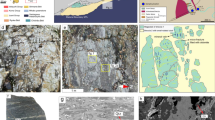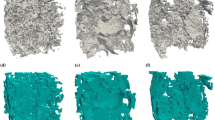Abstract
We identify two interrelated but independent species of microcracks with different origins and different distributions. One species is the classic high-stress microcracks identified in laboratory stress-cells associated with acoustic emissions as microcracks open with increasing stress. The other species is the low-stress distributions of closely-spaced stress-aligned fluid-saturated microcracks that observations of shear-wave splitting (SWS) demonstrate pervade almost all in situ rocks in the upper crust, the lower crust, and the uppermost 400 km of the mantle. On some occasions these two sets of microcracks may be interrelated and similar (hence ‘species’) but they typically have fundamentally-different properties, different distributions, and different implications. The importance for hydrocarbon exploration and recovery is that SWS in hydrocarbon reservoirs monitors crack alignments and preferred directions of fluid-flow. The importance for earthquake seismology is that SWS above small earthquakes monitors the effects of increasing stress on the pervasive low-stress microcrack distributions so that stress-accumulation before, possibly distant, earthquakes can be recognised and impending earthquakes stress-forecast.
Similar content being viewed by others
References
Alford, R. M., 1986, Shear data in the presence of azimuthal anisotropy: Dilley Texas: 56th Ann. Internat. SEG Mtg., Expanded Abstracts, 476–379.
Angerer, E., Crampin, S., Li, X.-Y., and Davis, T. L., 2002, Processing modelling and predicting time-lapse effects of overpressured fluid-injection in a fractured reservoir: Geophysical Journal International, 149, 267–280.
Atkinson, B. K., and Rawlings, R. D., 1981, Acoustic emission during stress corrosion cracking in rocks: In Earthquake Prediction — an International Review: eds Simpson, D. W., and Richards P. G., AGU Maurice Ewing, Series, 4, 605–616.
Bianco, F., Scarfi, L., Del Pezzo, E., and Patanè, D., 2006, Shear wave splitting changes associated with the 2001 volcanic eruption on Mt Etna: Geophysical Journal International, 167, 959–967.
Crampin, S., 1993, A review of the effects of crack geometry on wave propagation through aligned cracks: Canadian Journal of Exploration Geophysics, 29, 3–17.
Crampin, S., 1994, The fracture criticality of crustal rocks: Geophysical Journal International, 118, 428–438.
Crampin, S., 1999, Calculable fluid-rock interactions: Journal of the Geological Society, 156, 501–514.
Crampin, S., 2003a, Aligned cracks not LPO as the cause of mantle anisotropy. EGS-AGU-EUG Joint Ass Nice, Geophys Res Abst 5: 00205; with up-dated notes in online version.
Crampin, S., 2003b, The New Geophysics: shear-wave splitting provides a window into the crack-critical rock mass: The Leading Edge, 22, 536–549.
Crampin, S., 2004, The New Geophysics: implications for hydrocarbon recovery and possible contamination of time-lapse seismic: First Break, 22, 73–82.
Crampin, S., 2006, The New Geophysics: a new understanding of fluid-rock deformation: In Eurock 2006: Multiphysics coupling and long term behaviour in rock mechanics, eds Van Cotthem, A., Charlier, R., Thimus, J.-F., and Tshibangu, J.-T, Taylor and Francis, London, 539–544.
Crampin, S., 2012, Misunderstandings in comments and replies about the ICEF Report: available only online as relevant journals will not consider Replies to Replies.
Crampin, S., and Gao, Y., 2012, Plate-wide deformation before the Sumatra-Andaman Earthquake: Journal of Asian Earth Science, 62, 501–509.
Crampin, S., and Gao, Y., 2013, The New Geophysics: Terra Nova, 25, 173–180.
Crampin, S., and Peacock, S., 2005, A review of shearwave splitting in the compliant crack-critical anisotropic Earth: Wave Motion, 41, 59–77.
Crampin, S., and Peacock, S., 2008, A review of the current understanding of shear-wave splitting and common fallacies in interpretation: Wave Motion, 45, 675–722.
Crampin, S., and Zatsepin S. V., 1997, Modelling the compliance of crustal rock: II — response to temporal changes before earthquakes: Geophysical Journal International, 129, 495–506.
Crampin, S., Evans, R., and Atkinson, B. K., 1984, Earthquake prediction: a new physical basis: Geophysical Journal International, 76, 147–156.
Crampin, S., Volti, T., and Stefánsson, R., 1999, A successfully stress-forecast earthquake: Geophysical Journal International, 138, F1–F5.
Crampin, S., Volti, T., Chastin, S., Gudmundsson, A., and Stefánsson, R., 2002, Indication of high pore-fluid pressures in a seismically-active fault zone: Geophysical Journal International, 151, F1–F5.
Crampin, S., Chastin, S., and Gao, Y., 2003, Shear-wave splitting in a critical crust: III — preliminary report of multi-variable measurements in active tectonics: Journal Applied Geophysics, Special Issue, 54, 265–277.
Crampin, S., Peacock, S., Gao, Y., and Chastin, S., 2004a, The scatter of time-delays in shear-wave splitting above small earthquakes: Geophysical Journal International, 156, 39–44.
Crampin, S., Volti, T., and Stefánsson, R., 2004b, Response to “A statistical evaluation of a ‘stress-forecast’ earthquake” by Seher, T., and Main, I. G.: Geophysical Journal International, 157, 194–199.
Crampin, S., Gao, Y., and Peacock, S., 2008, Stress-forecasting (not predicting) earthquakes: A paradigm shift?: Geology, 36, 427–430.
Crampin, S., Gao, Y., and De Santis, A., 2013, A few earthquake conundrums resolved: Journal of Asian Earth Science, 62, 501–509.
Cruts, H. M. A., Groenenboom, J., Duijndam, A. J. W., and Fokkema, J. T., 1995, Experimental verification of stress-induced anisotropy. 65th Ann. Internat. SEG Mtg., Expanded Abstracts, 894–897.
Davies, P., 1989, The New Physics: a synthesis: In The New Physics. ed Davies P, Camb Univ Press, 1–6.
Gao, Y., and Crampin, S., 2003, Temporal variation of shear-wave splitting in field and laboratory in China: Journal of Applied Geophysics, Special Issue, 54, 279–287.
Gao, Y., and Crampin, S., 2004, Observations of stress relaxation before earthquakes: Geophysical Journal International, 157, 578–582.
Gao, Y., and Crampin, S., 2008, Shear-wave splitting and earthquake forecasting: Terra Nova, 20, 440–448.
Gao, Y., Wang, P., Zheng, S., Wang, M., Chen, Y.-T., and Zhou, H., 1998, Temporal changes in shear-wave splitting at an isolated swarm of small earthquakes in 1992 near Dongfang Hainan Island Southern China: Geophysical Journal International, 135, 102–112.
Gutenberg, B., and Richter, C. F., 1956, Frequency of earthquakes in California: Bulletin of the Seismological Society, America, 34, 185–188.
Kaiser, J., 1950, An investigation into the occurrence of noises in tensile tests or a study of acoustic phenomena: PhD thesis, Technical University, Munich, Germany.
Kranz, R. L,, 1983, Microcracks in rocks: a review: Tectonophysics, 100, 449–480.
Lockner, D. A., 1993, The role of acoustic emission in the study of rock fracture: Journal of Rock Mechanics and Mining Science and Geomechanical Abstracts, 30, 883–899.
Main, I. G., Sammonds, P. R., and Meredith, P. G., 1993, Application of a modified Griffith criterion to the evolution of fractal damage during compressional rock failure. Geophysical Journal International, 115, 367–380.
Mueller, M. C., 1991, Prediction of lateral variability in fracture intensity using multicomponent shear-wave surface seismic as a precursor to horizontal drilling in the Austin chalk: Geophysical Journal International, 107, 409–415.
Simmons, G., and Richter, D., 1976, Microcracks in rock: In The Physics and Chemistry of Minerals and Rocks, ed Strens, R. G. J., Wiley, New York, 105–137.
Teanby, N. A., Kendall, J.-M., Jones, R. H., and van der Baan, M., 2004, Stress-induced temporal variations in seismic anisotropy observed in microseismic data: Geophysical Journal International, 156, 459–466.
Volti, T., and Crampin, S., 2003a, A four-year study of shear-wave splitting in Iceland: 1 Background and preliminary analysis. In New insights into structural interpretation and modelling, ed Nieuwland, D. A., Geological Society, London, Special Publication, 212, 117–133
Volti, T., and Crampin, S., 2003b, A four-year study of shear-wave splitting in Iceland: 2 Temporal changes before earthquakes and volcanic eruptions. In New insights into structural interpretation and modelling, ed Nieuwland, D. A., Geological Society, London, Special Publication, 212, 117–133
Xue, L., Li, H.-B., Brodsky, E. E., et al., 2013, Continuous permeability measurements record healing inside the Wenchuan earthquake zone: Science, 340, 1555–1559.
Available at www.geos.ed.ac.uk/homes/scrampin/opinion
Author information
Authors and Affiliations
Corresponding author
Additional information
This study was partially supported by the National Natural Science Foundation of China (No. 41174042).
Stuart Crampin (PhD, ScD, FRSE, FAGU, Conrad Schlumberger Award, EAGE, Virgil Kauffman Gold Medal, SEG) at British- Geological-Survey, Edinburgh, pioneered theory, observation, and interpretation of seismic anisotropy and shear-wave splitting in stress-aligned fluid-saturated microcracks pervasive throughout the Earth’s crust and upper-mantle. In 1988, Crampin founded Edinburgh-Anisotropy-Project (EAP) oil-company consortium, currently led by Professor Xiang-Yang Li. EAP is a research consortium supported by 10∼15 oilcompanies, which received the 2012 SEG Distinguished Achievement Award. Crampin (www.geos.ed.ac.uk/homes/scrampin/opinion) and EAP (www.eap.bgs.ac.uk) have extensive experience (∼40 years, ∼350 research papers) of the theory, calculation, and interpretation of shear-wave splitting in both exploration and earthquake seismology.
Rights and permissions
About this article
Cite this article
Stuart, C., Gao, Y. Two species of microcracks. Appl. Geophys. 11, 1–8 (2014). https://doi.org/10.1007/s11770-014-0415-7
Received:
Revised:
Published:
Issue Date:
DOI: https://doi.org/10.1007/s11770-014-0415-7




